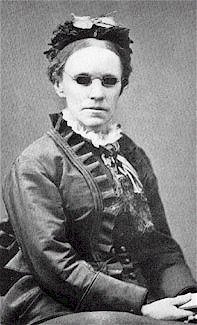
“Blessed Assurance” is not a hymn that I think of often. I mean, can you think of another hymn off hand with as archaic language, or which can be half as deadly in a church service when sung horribly slow for some unknown reason? I guess it depends on what kind of church you went to. And yet, it endures…
Blessed assurance, Jesus is mine!
Oh What A fore-taste of glory divine!
It’s unfortunate how interpretation can take a vital work and make it dull. Look at those exclamation marks! When put with the tune, those words bloom.
Fanny J. Crosby knew a little something about writing a lyric and pairing it with a tune. Blind from the age of 6 weeks, she was a prolific songwriter, penning over 2000 songs of spiritual and secular lyric. She also wrote cantatas, books and poetry. She was so prolific that she had to write under literally hundreds of pen names for her songs to make it into hymnals.
It can be easy to sing this song and find it mawkish or boring. I mean, even for Crosby every song can’t be a winner, right? A first, superficial glance at the lyrics and they seem trite and self serving… “Perfect submission, all is at rest, I in my Savior am happy and blest”… well good for you honey. However, I think that there is something very important in the concept of this song that I personally forget to honor and it is right there in the title.
A pet peeve of mine in religious song is an over abundance of focus on meeting the Lord in the afterlife. I mean, it’s a great thing. It’s an amazing beautiful wonderful thing. But I live in there here and now. There is something to acknowledging that Jesus is mine as I serve and love right now. I’m an heir right now, and how easy it can be to forget. Yes, I am his but he is mine…!
In her time, Fanny Crosby lived in the here and now as well. I look at her photo and think of her story and song of praising her Savior (all the day long). That woman was the first to be heard on the senate floor (reading poetry, but still). She lived in poverty to work in the inner city of her day. Some accounts have her struggling with the balance between socio-political reform and love/service.
For Fanny Crosby to write of delight and “visions of rapture now burst on my sight”… the idea of that kind of joy is transformative. The photos of her make her look like an unfeeling old woman, not an innovator of the turn of the century with a strong artistic voice and passion… which is what she was. “Blessed Assurance”, when sung with understanding, becomes a song of heirship, of power, and of daily promise of the here and now reality of an Eternal service.
Look at Fanny Crosby again… there’s something a little punk rock about her now, admit it. I’ve read so much about her legacy, and yet I don’t know that any of it conveys what it must have been like for her at all as an artist, as a Jesus lover, as a social activist, as a “rescue missionary”, as a blind woman… she left her life’s legacy to words and her soul to the assurance that Jesus was hers.
Fun fact. One of my favorite devotional readings is an old hymnal I’ve kept around for years. The songs are great, but taking time to read and meditate on the lyrics can be a wonderful part of one’s devotional life.
Everyone should have a hymnal in their home.
LikeLiked by 1 person
I agree! I have such a love of hymns. I was given a hymnal for my graduation and it’s still one of my favorite devotional materials. I managed to make that sound super fusty, but I find it so useful.
LikeLiked by 1 person
I read this really interesting book called “Altar at Home” that had a chapter on hymns with a lot of history that was totally news to me (maybe it isn’t to you), including that before the mid 1800’s hymns were primarily used for private devotional purposes. I found this quote, from a section on the shift from psalmody to hymnody in American corporate worship really interesting. It’s funny how arguments against moving to hymns are strangely similar to the arguments against moving to choruses and worship songs.
“In the eyes of conservatives, hymns were associated with heterodoxy, vulgar public displays, and lax doctrinal supervision, and it was only in the Second Great Awakening that hymns were thrust into the religious mainstream, popularized at revival meetings and strongly promoted by Methodists; as a religious genre both composed and sung by common citizens, without the sanction or supervision of clergy, the hymn encapsulated the era’s populist, anti-clerical spirit.”
Stokes, Claudia. Altar at Home : Sentimental Literature and Nineteenth-Century American Religion. Philadelphia, PA, USA: University of Pennsylvania Press, 2014. ProQuest ebrary. Web. 30 January 2016.
LikeLiked by 1 person